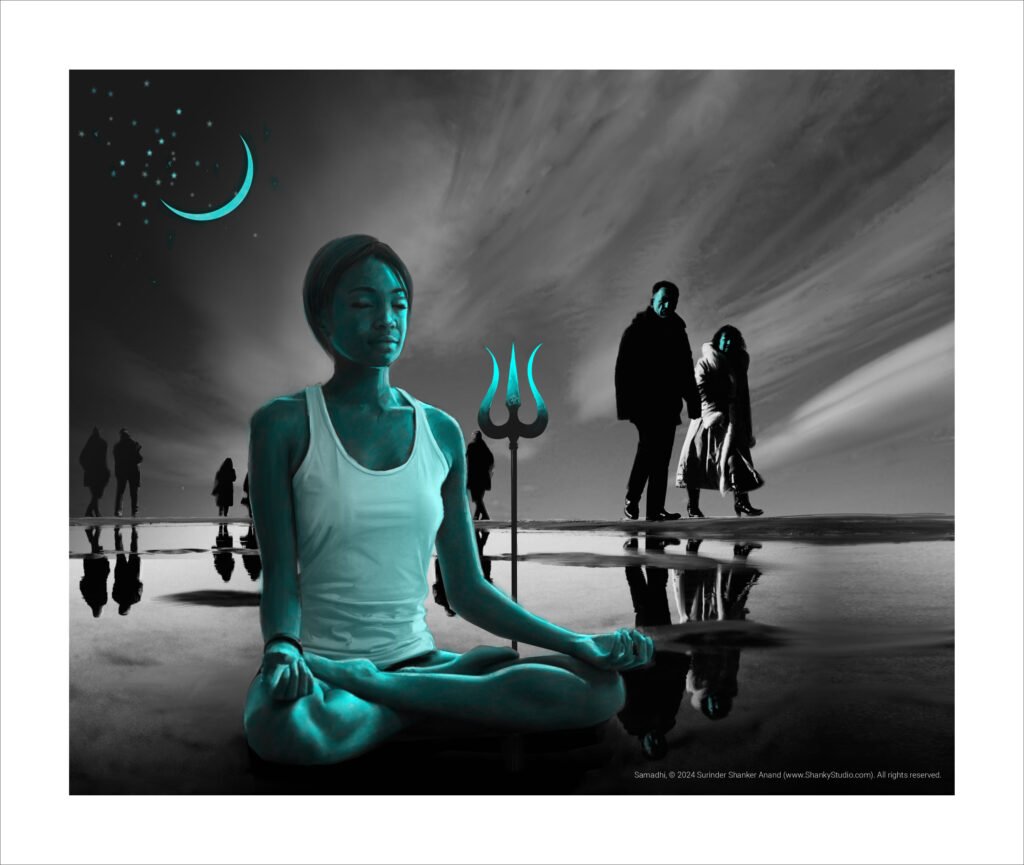Introduction
In this artwork, the final moment of spiritual culmination is depicted by blending concepts from ancient Indian scriptures, such as Yog Darshan, Sankhya Darshan, and using various symbols from Kashmir Shaivism.
The black trident represents Ishwara or Purush-vishesh (pure Consciousness), while the vibrant cyan symbolizes Prakriti (inert matter), and the meditating girl embodies Purusha (separative Consciousness), whose ultimate objective is to attain Kaivalya (Purusha fully and permanently separates from Prakriti).
Yogi’s paradoxical journey begins with Sankalp (determination) and ends in Samarpan (surrender), overcoming Avidya (false cognition) through Vivek-khyati (discriminative wisdom of Purusha and Prakriti), attained through consistent Abhyasa (practice) and Para-vairagya (supreme detachment).
In this final moment, the girl is attaining Asamprajnata Samadhi (Consciousness abides in Itself, free from any object of focus) marking the last and the final step toward Kaivalya, the liberation of Yog Darshan.

The primary focus of the artwork is on the meditating girl, with a half-gaze, symbolizes the remarkable qualities of the feminine mind — such as reverence, devotion, surrender, acceptance, equanimity, and contentment — that are highly conducive to attaining Liberation.
1 of 8The spectators’ reflections appear on the ground, indicating that their consciousness is engrossed and entangled in the gross matter of the transient external world.
2 of 8The black portion of the trident, which matches the color of the canvas and serves as the substratum, symbolizes pure consciousness, while the vibrant cyan represents material power. Together, they reflect the axiomatic principle of Shiva, the Conscious element, and His inseparable material power, Shakti. Positioned at the centre of the artwork, the trident represents the sole Source of the universe, with its three prongs embodying three core qualities of material power — light, activity, and inertia. The all-encompassing light of Divinity illuminates the girl, the beach, the people, the moon, the stars, the entire universe, and beyond.
3 of 8The clouds in the sky are drifting toward the meditating girl, as if the entire universe is guiding her in her final journey to realize the Truth. The boundless sky, the soft glow of dawn, and the gentle light of the auspicious new moon in the Pushya constellation symbolize the unfolding of the mystery through grace, not effort, reflecting the mind’s natural emptiness and the dawn of awakening.
4 of 8In the process of materialization, from subtle to gross, material power gives rise to 24 elements, symbolized by a cluster of 24 stars, in the top right corner. This includes the evolution from the primordial material power to the five fundamental elements — space, air, fire, water, and earth — each represented by the sky, cloud movement, cyan light, water on the beach, and the beach itself respectively.
5 of 8The ignorant people on the left side of the artwork are consumed by their own darkness of ignorance and are unable to perceive the divine phenomenon occurring with the meditating girl.
6 of 8The girl’s inward-drawn consciousness, seated in lotus pose with hand gesture of emptiness and illuminated by the cyan light, symbolizes her journey from darkness to light, leading to Samadhi and ultimately to liberation, where separative consciousness becomes indifferent to material power and is fully established in Itself, signifying the ultimate state of liberation.
7 of 8In this artwork, the final moment of spiritual culmination is depicted by blending concepts from ancient Indian scriptures, such as Yog and Sankhya Darshan, using various symbols from Kashmir Shaiv Darshan. Created by Surinder Shanker Anand at www.ShankyStudio.com
8 of 8Various symbolic visual elements, such as the two-colored trident, the meditating girl with a half-gaze, the beach, the spectators and their reflections on the water, the mystical dawn with the auspicious new moon in the Pushya celestial constellation, a cluster of 24 stars, electric cyan light on black & grey background, and drifting clouds in the sky, have been used to shape the concept of this artwork –
- Trident: The black portion of the trident, which matches the color of the canvas and serves as the substratum, symbolizes Ishwara, while the vibrant cyan represents Prakriti. Together, they reflect the axiomatic principle of Shiva, the Conscious element, and His inseparable material power, Shakti. Positioned at the centre of the artwork, the trident represents the sole Source of the universe, with its three prongs embodying Shakti’s three core qualities (Gunnas) — light (Sattva), activity (Rajas), and inertia (Tamas). The all-encompassing light of Divinity illuminates the girl, the beach, the people, the moon, the stars, the entire universe, and beyond.
- Five Elements: In the process of materialization, from subtle to gross, Prakriti gives rise to 24 elements, symbolized by a cluster of 24 stars, in the top right corner. This includes the evolution from the primordial Prakriti to the five fundamental elements — space, air, fire, water, and earth — each represented by the sky, cloud movement, cyan light, water on the beach, and the beach itself, respectively.
- Sky: The clouds in the sky are drifting toward the meditating girl, as if the entire universe is guiding her in her final journey to realize the Truth. The boundless sky, the soft glow of dawn, and the gentle light of the auspicious new moon in the Pushya constellation symbolize the unfolding of the mystery through grace, not effort, reflecting the mind’s natural emptiness and the dawn of awakening.
- Meditating Girl: The primary focus of the artwork is on the meditating girl, with a half-gaze, symbolizes the remarkable qualities of the feminine mind — such as reverence, devotion, surrender, acceptance, equanimity, and contentment — that are highly conducive to attaining Kaivalya.
- Reflections: The girl is detached from materialism (Prakriti) and her internalized consciousness is fully absorbed in herself, and therefore, there is no external reflection of her on the ground. In contrast, the spectators’ reflections appear on the ground, indicating that their consciousness is engrossed and entangled in the gross matter of the transient external world. On the other hand, the ignorant people on the left side of the artwork are consumed by their own darkness of ignorance and are unable to perceive the divine phenomenon occurring with the meditating girl.
- Kaivalya: The girl’s inward-drawn consciousness, seated in Padmasana (lotus pose) with Shunya Mudra (hand gesture of emptiness) and illuminated by the cyan light, symbolizes her journey from darkness (Avidya) to light (Vivek-khyati), leading to Asamprajnata Samadhi and ultimately to Kaivalya, where Purusha becomes indifferent to Prakriti and is fully established in Itself, signifying the ultimate state of liberation.
Composition & Implementation of Design
- Rule Of Thirds Grid: From a design perspective, the objects are arranged according to the rule of thirds grid, a 3 x 3 layout that divides the artwork into nine equal sections, creating four intersection points. The girl’s face, the middle portion of her torso, the main spectator’s face, and the spectator’s reflection are positioned at these four intersections.
- Diagonal Alignment: The Pushya conciliation, moon, the girl’s face, the trident, and the main spectator’s reflection follow a diagonal line from the top left to the bottom right, guiding the viewer’s eye. The same applies to the alignment of the cluster of 24 stars, the spectator’s face, the trident, and the girl’s torso. Also, the trident is positioned at the centre of the artwork.
- Layers: Multiple layers have been created in this artwork to convey three-dimensional depth. The girl and the trident are in the first layer. The spectator on the right and their reflection are in the second layer, while the other spectators in the dark area are in the third layer. The horizon, the celestial bodies and background make up the fourth layer.
- Focal Point: The meditating girl serves as the clear focal point of the artwork, with thoughtfully crafted design elements guiding the viewer’s attention toward her. The vibrant electric cyan, set against the muted black and grey background, instantly draws the eye, while the meticulous detailing of her figure enhances this focus. Positioned the girl’s face at the top-left intersection of the rule of thirds grid, she naturally anchors the composition. The surrounding clouds and the gaze of the main spectator within the scene subtly lead the viewer back to her, and her placement in the foreground reinforces her prominence.
ॐ तत्सत् ! ईश्वरार्पणमस्तु !!
Online Visual Art Courses for Adults & Kids
Best quality in best prices
Fundamentals | Acrylic Painting | Watercolor Painting | Oil Color Painting | Colored Pencil Painting | Soft Pastel Paintings | Portrait | Landscape | Abstract | Digital Design | Human Anatomy | Fashion Illustration |


Pingback: ElementWor #11395 - Shanky Studio